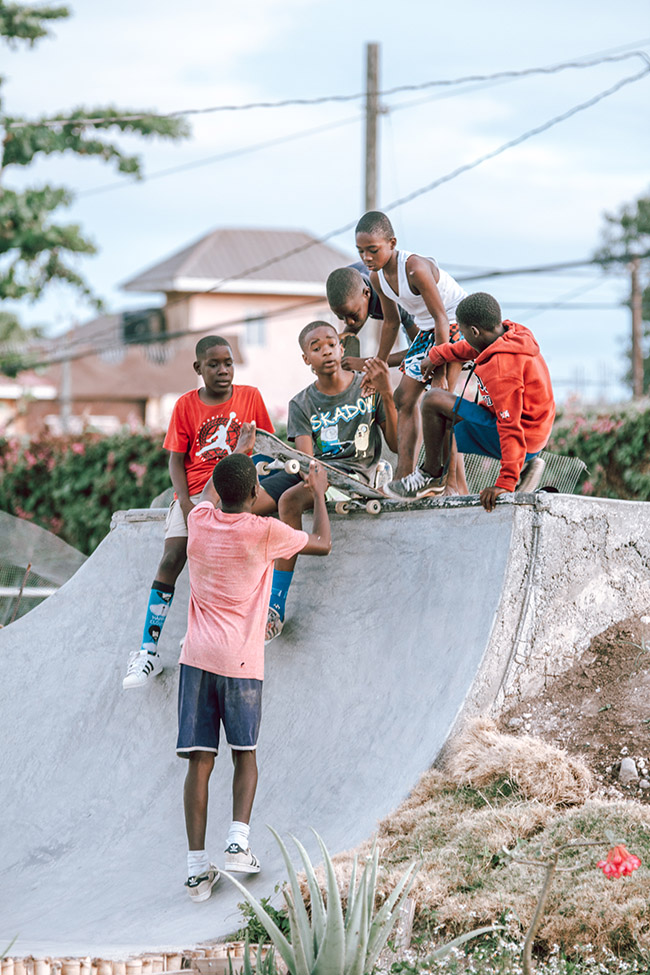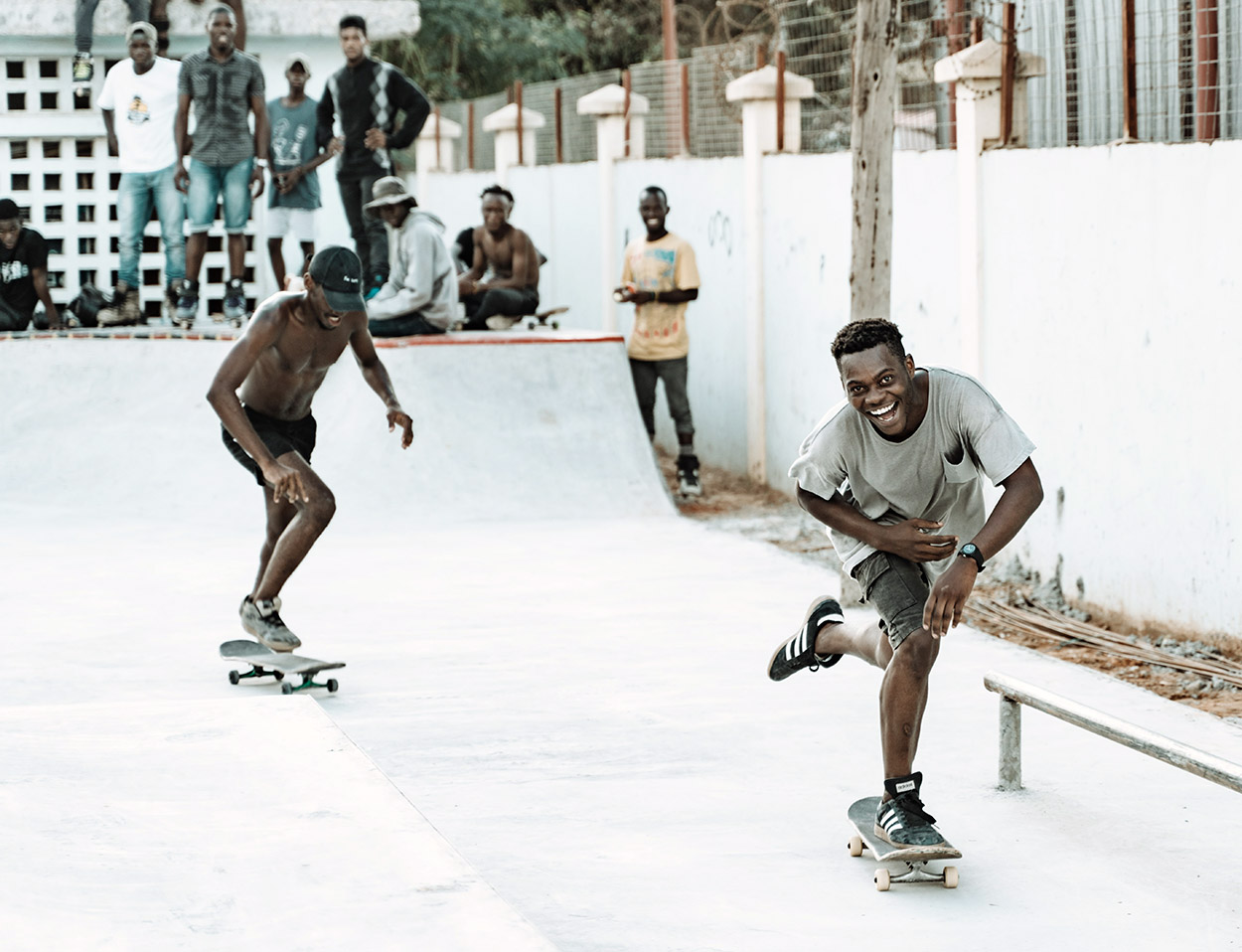A part être une chanson de Bob Marley, Concrete Jungle c’est aussi une ONG parmi quelques autres qui tentent par tous les moyens de donner accès au skate à des gamins qui sans leur intervention, n’auraient probablement jamais posé le pied sur une board. Mais comment ça marche, leur truc ? D’où vient l’argent et où va-t-il ? Elements de réponse ci-dessous, en toute transparence avec Troy Björkman.
(Pour la version française, il y a des outils de traduction à dispo, dont celui-là…)

CJF Jamaica 2020: Bob Zevenbergen, Troy Björkman, Clément Taquet, Harry Gerrard, Lisa Jacob, Tim van Asdonck. Photo: Ayden Stoefen
How many people work for CJF, I mean full time?
Troy Björkman : On the international side we have 3 people working full time. Our executive director Clément, our programme director Tim, and myself. We also have part-time staff that help with grants, impact reporting and the construction side of things. At our project locations we typically have 2-3 people working full-time. In Peru there’s Arissa, Karman & Jhikson. In Jamaica there’s Blake, supported by a lot of part-time staff, and in Morocco there’s Hanota, Kamal & Arthur.
What is your position?
I work on fundraising and communications. In practice that means writing a whole bunch of emails haha. I reach out to people, ensure that those who support us are kept up to date with what we’re doing. And also do events, collabs, merch, social media, and all that. It’s the laptop life for me.
„IT’S PRETTY NUTS WHAT YOU CAN GET DONE WITH €120 000!“
What’s Lisa Jacob’s position?
Lisa works part-time as CJF’s construction officer, so she manages all our builds as well as the skatepark construction apprenticeship programme (called Planting Seeds). But she helps out with events and fundraising too.
Where is it registered and when was it created?
Harry (Gerrard) and Clément (Taquet) started everything back in 2016 when they launched a crowdfunding campaign and built the first CJF skatepark for a school in Trujillo, Peru. Tim (van Asdonck) soon came on board to run the first youth programmes, and I got involved as a volunteer to help him. CJF was formally registered as a UK charity in March 2018, and we’ve since also registered in the EU (The Netherlands) and the US.
How does it work, concretely? Where does the money come from?
It varies a bit year to year, but the breakdown for our annual budget is currently something along these lines: commercial partnerships and grants (60%), monthly donors (15%), events (10%), fundraising campaigns (10%), merch (5%). For the last annual report we filed we had an annual turnover of roughly £105,000 or €120,000. All the numbers are publicly available via the UK Charity Commission’s website.
2020
Commercial partnerships & grants are the biggest share, what’s the classic deal? How do you manage the commercial and social side of things together?
Sometimes we do one-off activations or collaborations with companies, especially if we start working with someone new. But over the long-term, we always aim towards establishing what we call Key Partnerships, where companies come on board over a longer period of time in exchange for being credited as the main enabling entities of all CJF’s social impact (skateparks, programmes, grants, etc.). Such multi-year partnerships provide the stability needed to know that our project locations will be safe. So right now, for example, The Skateroom, New Line Skateparks, Moomin, Vans France, Mud Crew and Clown Skateboards are our Key Partners. They support us financially and so are the main entities that make all the work we do possible. They’re the lifeblood of what we do. And in exchange we credit them as such. I think it’s important to point out that these companies (or more specifically, the people representing them) almost always get involved purely because they share our vision of skateboarding as a force for good – they want to give back to skateboarding and support underserved scenes and kids around the world. But of course we also try to provide as much value to them as possible: impact reports, custom media requests, logo placements, activations, events, and positive marketing and visibility generally (like in this article). The fact is that we wouldn’t be doing what we are without these individuals and companies coming on board to enable it. And since Key Partners stick around if they are happy about the social impact we co-create and the brand benefits they get in return, there’s just a super clear incentive for us to make sure that’s the case. So we make sure that’s the case.
And how is it spent? I mean, how much of the whole money is spread between administration and actual work overseas?
In 2021-2022 we spent 11% on admin & fixed costs, 12% on fundraising & marketing, 38% on operations (i.e. skatepark building), and 39% on the ongoing youth programmes we run across our project locations. To be perfectly clear, admin is basically Clem’s salary plus stuff like accounting, platform fees, etc. We don’t have an office or anything, everyone just works from their couch. Fundraising & marketing includes my salary plus events and merch investments. Operations covered the building of two skateparks in Peru and one in Morocco. And youth programmes include Tim’s salary plus all the costs associated with running skateboarding, homework & professional programme for 315 kids across our project locations. When you look back at it, it’s pretty nuts what you can get done with €120,000!
Are you close with some other skate-NGO’s? How different is what you guys do than the others?
We’re pretty close with Wonders Around the World, as Lisa (Jacob) has worked with them a lot and we were blessed to have Léo Poulet on board for one of our builds. He’s an amazing person (not to mention builder), so I’m stoked to hear he’s heading the charity there now. We also partner with a bunch of other organizations like Free Movement Skateboarding and Skate Nottingham on youth programming. And we’ve helped get some builders on board for other skate NGO projects too. We try not to compare ourselves too much with what others are doing, but I think it’s common knowledge that the main difference is our long-term approach to the project locations. Basically, once our parks are constructed they’re run as youth centers, providing free programmes in skateboarding, life-skills, homework & tutoring, professional development, social counseling, and so on. We invest a lot in the local community by providing employment opportunities and helping the locals start their own organizations so that they can formally take over running the project over time. In Jamaica we have the Freedom Skatepark Foundation, while in Peru the local crew decided to register as CJF Peru. Another thing that I think sets us apart is the formal approach we’ve adopted to transfer skatepark construction skills to local skate crews. In short, we budget our projects so that 3-6 local skaters can come on board on each build as paid apprentices, where they live and work with us full-time while going through a structured curriculum in skatepark construction to learn the whole process. And the results have been amazing. Jhikson, one of the first to go through the programme, just recently built his first own park independently in Peru, and has now been invited to go build with New Line Skateparks for a project they’re doing in Cambodia.
 Lobitos bowl, Péru, 2021. Photo: Clément Taquet
Lobitos bowl, Péru, 2021. Photo: Clément Taquet
What’s the greatest project you’ve done so far?
That’s a super hard question, as they all have a special place in my heart. If I had to choose I might say Jamaica, just because of the impact we’ve had there over the past couple of years. Jamaica is an amazing place and the people there are such an inspiration, but it also has some serious problems. In both 2020 and 2021 it had the highest homicide rate in all of Latin America and The Caribbean. I got robbed there twice on the same day. Basically, this is a place where youth development programmes are really needed, and it’s amazing to see how much has been achieved through the skatepark and the activities there.
I know you don’t only build skateparks, but you also do the follow up. How long do you keep track of what’s happening with a past project?
Like I mentioned, we stay actively involved on the ground once the parks are built. Our programmes director Tim typically stays at the project location for 12-15 months to help the locals set up the structure and get the programmes running smoothly. But this time it’s actually our former project manager Arthur that’s doing it in Morocco, although that’s kind of a special setting as we’re doing the project on the grounds of a children’s center. Today our active project locations in both Peru and Jamaica are 100% locally staffed. Tim has close contacts with them all the time, and then we have monthly project meetings where we help out, give advice, grant budgets, etc. The idea is that we help the locals develop an organization of their own that can take over most aspects of running youth programmes and activities, but still get support from us.
How do you finance that long run follow up?
A full year of youth programmes at each project location costs about 20-40k€ to run. We finance this through all the fundraising methods mentioned above. But we also work with the local community to develop regional financing streams so that the local organization can become less dependent on us over time. The idea originally was to get to a mostly locally funded structure within 5 years, but we haven’t quite gotten there. The most financially sustainable local organization is currently the Freedom Skatepark Foundation, which this year gets about 80% of its funding through stuff like local sponsorship deals and regional grants. For Peru and Morocco it’s still much less.
 Jamaica, 2020. Photo: Jago Stock
Jamaica, 2020. Photo: Jago Stock
Any project that failed?
While we don’t consider it a failed project, “the one that got away” was definitely Luanda, Angola. As our second project, we built the country’s first skatepark there in 2018 with a very tight budget. We had agreed with our local partners Angola Skateboarding Union (ASU) that we were going to work with them over the long-term to support the local community. But once it was built, we didn’t have any funds to bring them on board to help run it in the way that we do with our projects today. To be completely frank, there was also a personal element where we didn’t quite see eye to eye with the guy running the show over there. He kinda lost interest in us as soon as the skatepark was built. But hey, you live and learn. After that project we’ve definitely been way more prepared and structured when it comes to partnerships, financing models, the long-term vision, and so forth. In short, the project turned out as a more traditional charity skatepark build, just providing a park for the community – which is already great. Big shout out to the Luanda homies – Nilton, Fricky, Edmilson, little Chili and the whole DESART crew. They’re still ripping the park big time.
I guess in some places you must be facing local politics or even sometimes corruption. How do you deal with this?
Yes, this is definitely something we need to navigate on the regular. In Angola it was pretty tough, where officials clearly were delaying the construction permit in the hopes of monetary lubricant. But we’ve had great experiences too. Just recently for example we had Jamaica’s Minister of Culture, Gender, Entertainment, and Sport visiting the Freedom Skatepark to express his support for our work. I’ll leave a quote from his speech here: “Sports may not be able to solve every single minute detail of crime and violence, but certainly, it is highly effective when used and combined with other holistic interventions and programmes that can influence change and engender hope”. Would have been amazing if he had said ‘skateboarding’ instead of ‘sports’, but we’ll take it!
Was there other times than the Jamaica experience where you could feel it was getting dangerous?
Generally I’d say we’ve been pretty fortunate during our projects, but there’ve been a couple bad ideas and too close calls. In Angola we were working some incredibly long 7-day weeks towards the end of the build, and for some stupid reason we used to skitch behind cars in the middle of the night to get back to our place faster. One night we had been on site for probably 14 hours and had a big group hanging on to one car. The driver sped up way too much and speed wobbles led Lisa to a pretty serious head injury. Lots of blood, not fun. Thankfully we got to a hospital pretty quick and she was sown up. But you know Lisa, she was back on site the next day, although not fully working for a couple of days.
 Luanda, Angola, skatepark built in 2018. Photo: Ayden Stoefen
Luanda, Angola, skatepark built in 2018. Photo: Ayden Stoefen
How can I join the CJF as a worker?
People can get involved in CJF in a number of ways beyond building parks. We always try to have one or two international volunteers helping out to run youth programmes at the project locations, and you can apply for that via our website. Also, if you’re keen to do an internship with us in any field, get in touch and we’ll explore together how your interests could align with the work of the charity. Regarding coming on board as a worker for a skatepark build, you should know first up that there’s always more interest than there’s space on the team. Beyond skills and experience, what it ultimately boils down to is the extent to which you’ve helped make that project happen. If you see we’re launching a campaign for a new project, help us make it happen by organizing a local documentary screening, party or fundraiser. And most importantly, if you can, please join our monthly donor programme CJFamily, even with just a couple euros. CJFamily Members are the first ones to know about a new project, and they’re given first priority for all placements – be it as a worker, volunteer, intern or other.
